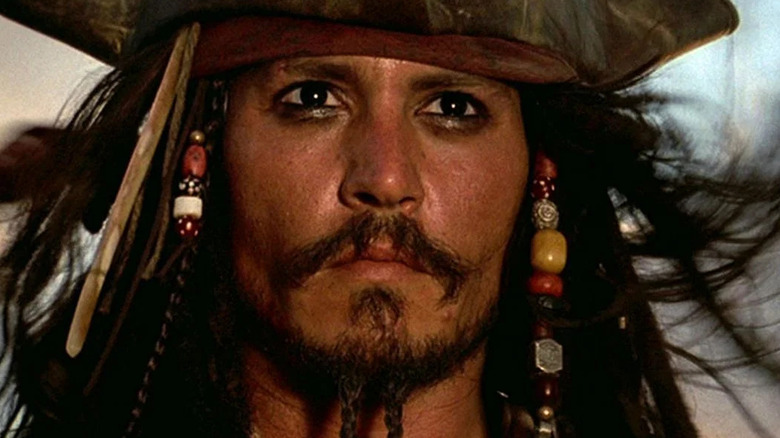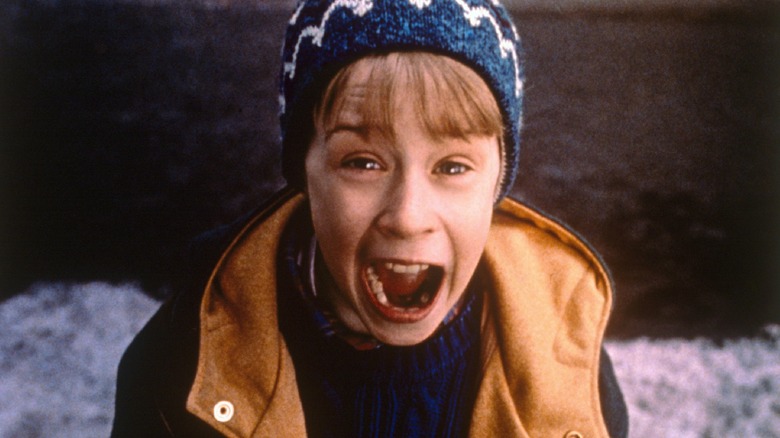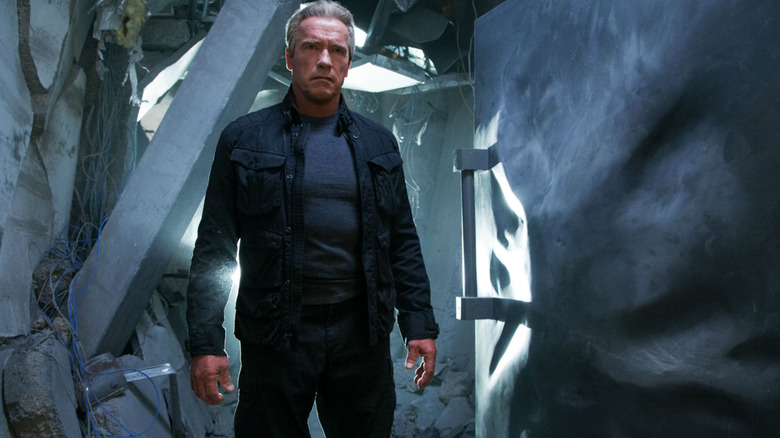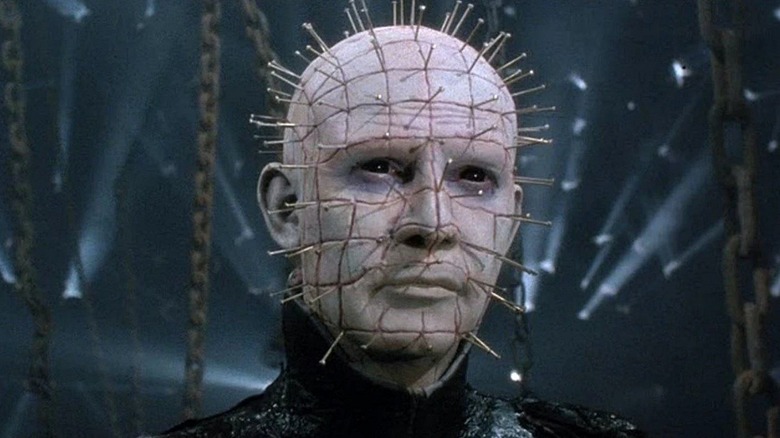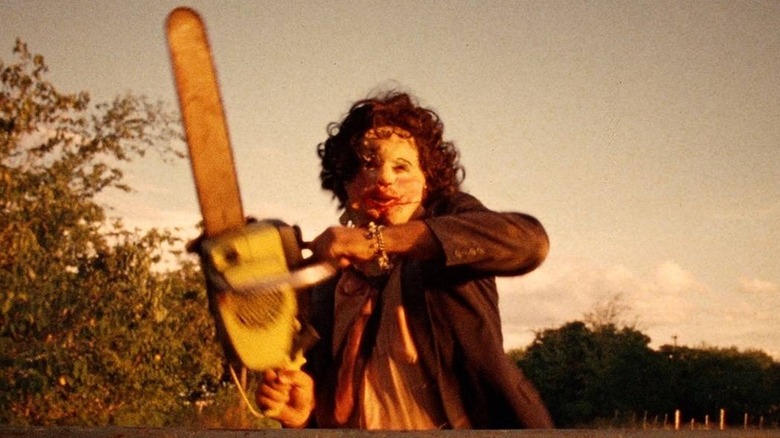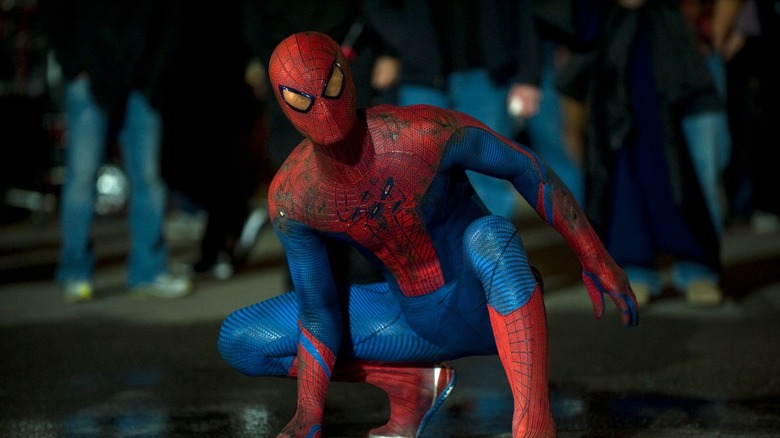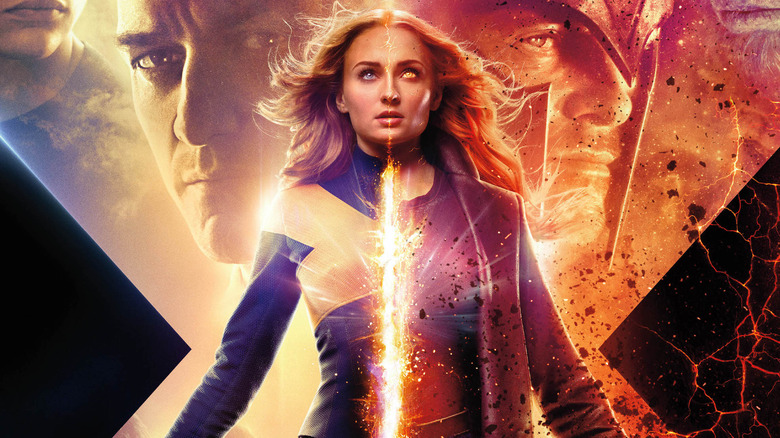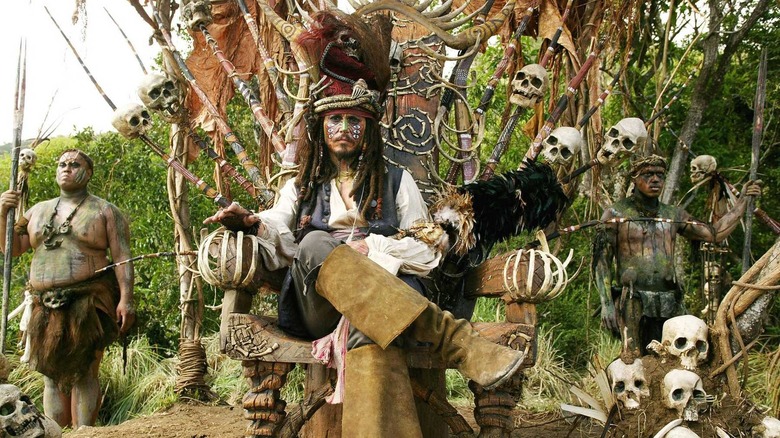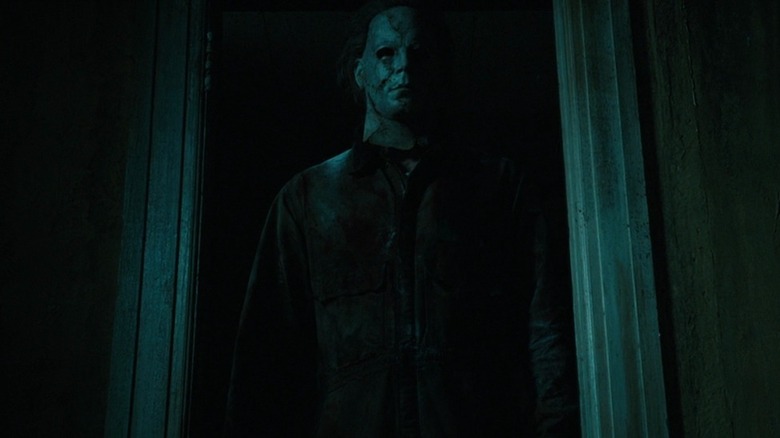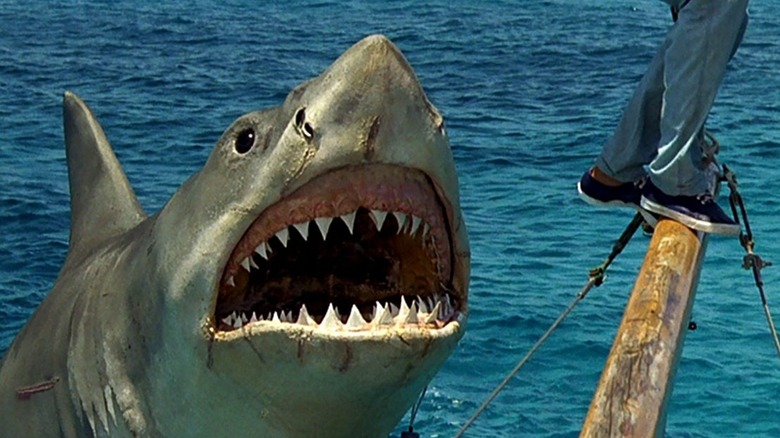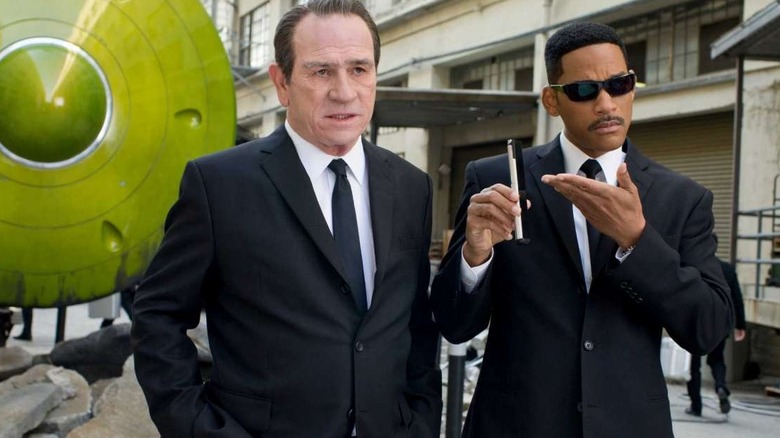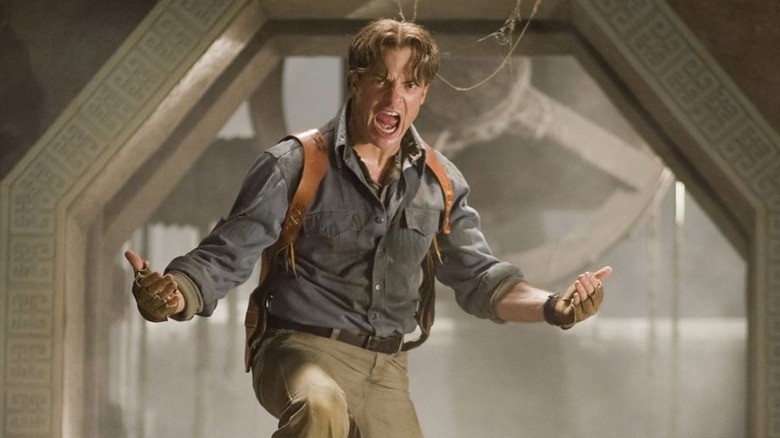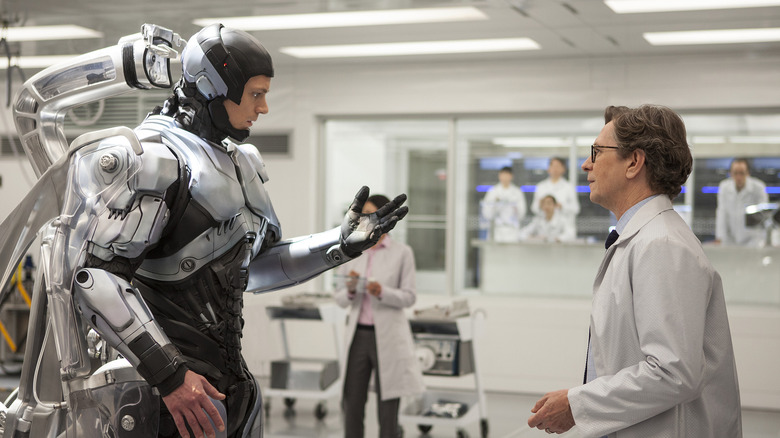Movie Franchises Butchered By The Studios More Than Once
A movie franchise is like a delicate piece of china. Handle it right, and it can dazzle people for years to come. Get clumsy with it, and you'll have a big mess on your hands and only memories of what was once so beautiful. Over the years, some long-running film franchises have been handled with extreme caution by the studios in charge of releasing and financing them. After all, a bad movie in one of these properties can have long-term effects that jeopardize profits. But there are just as many times that major studios opted to hurt a prized franchise not just once, but multiple times. The temptation of getting some easy money proved too alluring in these cases, resulting in projects that tainted the public image of once-beloved properties.
These instances are all tragic, but the specific circumstances informing the tragedy can vary greatly. Some of these franchises were butchered thanks to a slew of cheaply made direct-to-video follow-ups. Others got hurt thanks to a series of theatrical sequels that refused to confront significant flaws from prior entries. Whatever contributed to the low quality of these individual features, it's apparent that these movies are stark examples of studios releasing sequels that forever alter a franchise for the worst.
Home Alone
"Home Alone" was not a movie that suggested endless sequels. The original feature was a one-and-done adventure, with no dangling plot threads or themes that required multiple movies to explore. This was not "Star Wars" or "The Souvenir." But "Home Alone 2: Lost in New York" normalized the idea of sequels in this franchise, generating a trio of follow-ups that delivered coal in the stockings of moviegoers. The first of these follow-ups was "Home Alone 3," the last of these entries to debut on the big screen. Five years later, "Home Alone: Taking Back the House" continued the saga with an ABC premiere.
Though there were already an obscene amount of sequels in this saga, 20th Century Fox couldn't stop exploiting the "Home Alone" brand name for further cash grabs. In 2012, more than two decades after the original film, "Home Alone: The Holiday Heist" premiered on ABC Family. For nearly a decade afterward, the series laid dormant until Fox's new parent company, Disney, saw an opportunity to provide Yuletide content to Disney+. Thus, "Home Sweet Home Alone" provided the series with its sixth installment, with this one even bringing back Devin Ratray as Buzz McCallister. But whatever holiday joy audiences had with the first "Home Alone" was wiped out by Fox's endless barrage of sequels.
The Terminator
When Arnold Schwarzenegger said "I'll be back" in the original "The Terminator," who knew how right he'd be? The original "Terminator" has spawned a whopping five movie sequels. Thanks to the film rights to the property not being tied to one major American movie studio, the sequels have been floating around different studios for years. For instance, "Terminator 2: Judgment Day" was distributed by TriStar Pictures, while the fifth and sixth entries in the saga were collaborations between Skydance Productions and Paramount Pictures.
Warner Bros. was in charge of "Terminator 3: Rise of the Machines" and "Terminator: Salvation," two widely derided entries in the franchise. "Rise of the Machines" is seen as an improvement on later entries like "Terminator: Genisys," but it is the movie that began the series' cold streak after its first two classic entries. Next up was "Terminator: Salvation," a production that scored worse reviews than "Rise of the Machines" despite changing things up by taking place in the post-apocalyptic future. Through these entries, Warner Bros. began to dramatically alter the public's perception of the "Terminator" series decidedly for the worse, culminating in the box office failure of 2019's "Terminator: Dark Fate." Maybe this franchise shouldn't have come back so many times after all.
Hellraiser
The original "Hellraiser" was a seminal work of 1980s horror. Plucked straight from the brilliant mind of Clive Barker, "Hellraiser" gave birth to a new horror movie icon in Pinhead and delivered twisted images of gruesome murder and hellish sights that are still leaving their mark on horror cinema to this day. Alas, this being a scary feature from the 1980s, "Hellraiser" couldn't remain a single great motion picture. It had to receive an endless string of sequels, many of which came from Dimension Films. The genre movie label for the original Miramax, Dimension began handling this series with "Hellraiser III: Hell on Earth."
Following that, Dimension regularly cranked out new "Hellraiser" sequels, the majority of which went direct-to-video. These cheaply made follow-ups did little to properly expand on the original film and merely served as cash grabs milking a famous title. Projects like "Hellraiser: Hellseeker" and "Hellraiser: Hellworld" got starkly negative reviews, a far cry from the modern reputation that the initial "Hellraiser" received. But Dimension's treatment of "Hellraiser" hit a new low with the 2011 feature "Hellraiser: Revelations." Made for just $300,000, the project existed solely to ensure that Dimension held onto the rights to the "Hellraiser" franchise. Once upon a time, the name "Hellraiser" meant subversive horror. Tragically, Dimension Films twisted the saga's reputation in the name of easy profits.
The Texas Chainsaw Massacre
Leatherface has not had very good luck with getting a proper sequel to "The Texas Chain Saw Massacre." While none of the follow-ups in this franchise have been anything to write home about, Lionsgate provided the nadir of the series with its two contributions, "Texas Chainsaw 3D" and "Leatherface." The former was an attempt to wring some more dollars from moviegoers by projecting a run-of-the-mill slasher film in costly 3D ticket prices. Even more egregiously, though, was how "Texas Chainsaw 3D" tried to frame Leatherface as a tormented anti-hero. It was a bold swing for the franchise, but one that landed with a thud. Even the movie's lead actor, Alexandra Daddario, has openly admitted her problems with the project in recent years, particularly her disdain for the line "Do you thing, cuz."
Lionsgate didn't stop there with harming the "Texas Chainsaw" franchise. The 2017 installment "Leatherface" further diluted the appeal of the titular killer by diving into his origins. A character who proved so chilling in 1974 because of the mysterious aura that followed him around was now just another fictional character with a tragic backstory. Explaining things does not make them scarier — any good horror filmmaker will tell you that. Having "Iron Fist" leading man Finn Jones around in the cast only reinforced what a misbegotten endeavor this was. Both of these films missed the entire point of the killer they were depicting, ensuring that "Texas Chainsaw Massacre" hit new lows in critical reception.
Spider-Man
Sony/Columbia has an interesting history of making "Spider-Man" movies without Marvel Studios. On the one hand, the studio is responsible for two of the best "Spider-Man" features of all time: "Spider-Man 2" and "Spider-Man: Into the Spider-Verse." This studio has proven capable of crafting satisfying movies around the web-slinging superhero. Unfortunately, twice now the "Spider-Man" franchise has also been butchered by Sony/Columbia executives who got too excited about cramming so much "Spider-Man" lore into a single project.
First came "Spider-Man 3," a movie with its share of defenders online that has moments of greatness, including Thomas Haden Church's performance as Flint Marko/Sandman. Unfortunately, "Spider-Man 3" also features bits and pieces that just don't work, including reducing Sandman to a generic CG villain for the finale and Peter Parker physically abusing Mary Jane. The film hurt the overall "Spider-Man" series, but it still proved superior to "The Amazing Spider-Man 2" in 2014. This project featured everything from Spider-Man stalking a former lover to a bizarre interpretation of Max Dillon/Electro that ended up being superfluous to the plot. This particular movie turned out to be such a problematic entry in the saga that it stalled plans for a cinematic universe and led Sony to ask Marvel Studios to help craft new "Spider-Man" adventures.
X-Men
Having lasted for two decades and 13 different installments, it's inevitable that 20th Century Fox's run on the "X-Men" movies would produce some duds. What's shocking is just how badly these lackluster entries were: the studio produced three especially awful "X-Men" movies that represent the nadir of quality in this franchise. Though these characters have been referred to as "Merry Mutants" in the comics, no moviegoers were walking out of the theater chipper after watching these films.
The first among Fox's worst "X-Men" movies was "X-Men: The Last Stand," which merged a mutant cure storyline and a truncated adaptation of the "Dark Phoenix" comic book saga into one underwhelming package. Following that up was "X-Men Origins: Wolverine," which proved to be an awful affair even before the climax brought out a wildly miscalculated version of Deadpool. A decade after "Wolverine" sliced through movie theater screens, Fox delivered "Dark Phoenix," another attempt to get the storyline of the same name right in feature film form. Unfortunately, the lack of developed characters and inert visuals made "Dark Phoenix" totally lifeless. Coming hot off "X-Men" titles like "Logan" that were different and memorable, "Dark Phoenix" was run-of-the-mill and safe. It was the third (and thanks to the Disney/Fox merger, final) time 20th Century Fox delivered a subpar "X-Men" movie.
Pirates of the Carribbean
The original "Pirates of the Caribbean" movie defied all odds and made a fun adventure out of a theme park ride. Unfortunately, later entries in the franchise embodied the worst-case scenario of what "The Curse of the Black Pearl" might have been. Tantalized by massive worldwide box office hauls, Disney kept on pumping out "Pirates" sequels, resulting in terrible movies like "On Stranger Tides." The focus here shifted entirely onto Jack Sparrow and a bevy of generic supporting characters, including a laughably forgettable romance between a priest and a mermaid. Even more insulting was how director Rob Marshall draped so much of the movie in a gray overcast that made nighttime scenes borderline incomprehensible visually, especially when viewed in digital 3D.
The follow-up to "Stranger Tides," "Pirates of the Caribbean: Dead Men Tell No Tales," tried to streamline things (especially in its more succinct runtime), but only further tarnished the reputation of this franchise. Among the most egregious faults here were daring to provide a backstory for Jack Sparrow (including an explanation for his last name) and torturously overlong comic set pieces centered on that wacky pirate. It didn't help that the proceedings felt so derivative of previous "Pirates" movies. The innovation of the initial "Pirates" films had been replaced by sequels desperately trying to recreate the magic of prior installments. Disney's greed for more box office gold merely ensured that the days of loving "Pirates of the Caribbean" movies was a distant memory.
Halloween
Throughout the 1990s and 2000s, Dimension Films was behind several major horror franchises, including "Scream," "Hellraiser," and a string of "Halloween" sequels. "Halloween" had already delivered widely-disliked installments before Dimension got hold of the series, but Dimension's time as caretaker of the "Halloween" saga was full of frustrating creative decisions. This is particularly true of 2002's "Halloween: Resurrection," whose laundry list of shortcomings is longer than one's arm. Among the most baffling of these flaws was casually killing off Jamie Lee Curtis's Laurie Strode at the start of the movie and turning the grim world John Carpenter established decades earlier into a winking parody of itself.
The two Rob Zombie "Halloween" movies Dimension Films distributed in the late 2000s were an improvement over "Resurrection," but they still proved frustratingly antithetical to what made "Halloween" so interesting. Providing extensive backstory to Michael Myers and a gratingly bleak tone only made one yearn for a revisit of the original "Halloween" movie. The most unique creative impulses of Zombie's take on "Halloween" (including the decision to have "Weird Al" Yankovic cameo as himself in "Halloween II") are outweighed by too much hardcore violence that could have been lifted from any grimy horror title of the same era. The distinctiveness that made the original "Halloween" unforgettable was largely absent from Dimension's final stabs at extending the franchise.
Jaws
Nothing can taint the reputation of the original "Jaws." Decades after it forever changed the way people would look at beaches, "Jaws" remains so chilling that just humming a few bars from John Williams' theme is enough to send a shiver down your spine. Equally terrifying are two of its sequels, though not for the same reasons. "Jaws" is scary because of its expert filmmaking, whereas "Jaws 3D" and "Jaws: The Revenge" are scary because it's terrifying to imagine Universal Pictures executives signing off on making these features.
This pair of sequels attempted to further milk people's fear of sharks and love of the original movie. All they accomplished was ensuring that the initial masterpiece now had to share DVD shelves with truly abhorrent cinema. "Jaws 3D" is a run-of-the-mill bad horror sequel from the 1980s, complete with a 3D gimmick — just the sort of disposable fright-fest that "Jaws" subverted. "Jaws: The Revenge," meanwhile, is a special kind of all-time bad movie with staggeringly terrible narrative decisions. Chief among these is making the shark no longer a wild animal (which is what informed so much of the scariness of the first "Jaws") but an organism who plots intricate revenge schemes. Awful visual effects and great actors like Michael Caine getting saddled with wooden dialogue exacerbate the dismal quality. Everybody loves "Jaws," but you'd be hard-pressed to find someone who can sit through these two disasters.
Men in Black
The original "Men in Black" is still a bona fide classic, one of Will Smith's greatest star vehicles and featuring a bravura villain turn from Vincent D'Onofrio. Unfortunately, its studio, Sony/Columbia, does not have as many hit franchises as Disney or Warner Bros., so it was inevitable that they would try and turn "Men in Black" into an ongoing series. This resulted in "Men in Black II," which undid the touching ending of the first movie for a rehash of its predecessor's story, only this time with a much weaker villain. The gags were stale this go-around and it already felt like this franchise was running on fumes.
While "MIB3" restored a bit of the luster to this saga, Sony/Columbia plowed ahead in 2019 on a new chapter in the series entitled "Men in Black: International." The focus would shift to new characters played by Tessa Thompson and Chris Hemsworth. The opportunity to bring in new protagonists could have been a chance to really freshen up the "Men in Black" series. Instead, this installment once again plunged the franchise to new lows in quality, with terrible stabs at humor and a lack of visual imagination. The story also felt too cribbed from earlier movies, complete with yet another villain with a humanoid appearance that takes on a monstrous alien form in the climax. "Men in Black" once had such potential, but Sony/Columbia ruined it on two separate occasions.
The Mummy
Universal's classic yet musty bandage-wrapped monster, the mummy, got a swift burst of life in 1999 with the Stephen Sommers movie of the same name. "The Mummy" figured out that combining old-school action with charismatic performances from Brendan Fraser and Rachel Weisz was a recipe for blockbuster fun. Unfortunately, Universal would repeatedly ruin this series, with the first instance of this coming in 2008 with "The Mummy: Tomb of the Dragon Emperor." The absence of Weisz here was sorely felt, while director Rob Cohen, a newcomer to the franchise, filmed the action with a noticeable lack of excitement.
But "Dragon Emperor" practically looks like the original "Mummy" when compared to Universal's 2017 reboot, also called "The Mummy." Headlined by Tom Cruise and meant to kick off a shared world of films called Dark Universe, this take on "The Mummy" was plagued by way too much world-building, unintentional bursts of comedy (like when Russell Crowe's Dr. Jekyll transforms into a Scottish Mr. Hyde), and, most importantly, a tedious lack of both personality and fun. With crummy installments like these, Universal sent the once-thriving "Mummy" franchise back into its tomb.
RoboCop
Despite being one of the most beloved action movies of the 1980s, "RoboCop" has never managed to score a sequel that's proven to be anywhere near as acclaimed as that original movie. Granted, director Paul Verhoeven set a high bar for any successor to follow with his masterful blend of social commentary, unflinching violence, and dark humor. But the sequels, commissioned by Orion Pictures and its eventual owner MGM, would have been lackluster endeavors even if there wasn't an esteemed original "RoboCop" to compare them too.
This is especially true of the third and fourth entries in the franchise, the former of which was released as "RoboCop 3." Produced on a shoestring budget, this one didn't even have the decency to bring back Peter Weller as the titular crime-fighting cyborg. After a widely detested installment like this, it's no wonder the franchise laid dormant for two decades. In 2014, MGM brought the series back with "RoboCop," a remake starring Joel Kinnaman. Though not as downright awful as it could have been, this new "RoboCop" diluted the wit and gruesome carnage of the original in favor of generic blockbuster movie mayhem. In an attempt to make some easy box office bucks through a familiar brand name, MGM had merely proven once again how no sequel can recapture the magic of the first "RoboCop."
